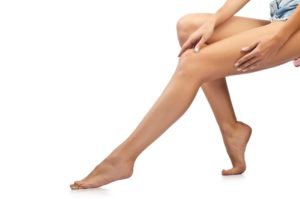Venous Leg Ulcer Treatment in Maryland
Vascular health is important and when it declines, many conditions can arise. This includes venous leg ulcers. These ulcers can lead to severe infections and in extreme cases, can become life threatening. Here are some venous leg ulcers FAQ and additional information.
When you receive an injury in your lower leg, and the wound simply doesn’t heal, it’s known as a leg ulcer.
Venous leg ulcers, meanwhile, are the most common type of leg ulcer. Essentially, when your circulation in your lower legs is poor, blood pools in your legs, and nutrients and oxygen don’t reach the injured tissue–leading to the wound never healing.
What is a Venous Leg Ulcer?
A venous ulcer is a chronic wound that forms on the leg ankle or foot. It is the result of poor vein function. Venous ulcers, or stasis ulcers, account for 80% of lower extremity ulcerations.
Normally, when you get a cut or a scratch, the body begins healing immediately. The veins deliver oxygen rich blood to the area, and those red blood cells help create collagen. Granulation forms and helps the wound close as new skin is generated. However, people with venous insufficiency don’t heal as well.
What is Venous Insufficiency?
Venous insufficiency occurs when veins don’t function properly. The valves in the veins don’t open and close correctly, preventing blood from flowing freely. As a result, the blood pressure in lower extremities remain highs. Blood pools in these veins and the nutrient-rich oxygen and blood cells can’t reach damaged tissues. This can cause a small cut to become a large open wound known as an ulcer.
What Causes Venous Leg Ulcers?
Venous leg ulcers are caused by poor vein function. This could be due to disease, blood clots or even inactivity.
How Can I Tell When My Leg Ulcer Is a Venous Leg Ulcer?
Symptoms that your leg ulcer is venous in nature include heaviness of the legs and swelling, an itching sensation, and discolored skin that indicates blood pooling.
Meanwhile, general venous insufficiency would be an indication that you have a vneous leg ulcer. If you have varicose veins of any sort, or suffer from a feeling of heaviness in the legs, or restless leg syndrome, there’s a chance you may have venous insufficiency.
Venous insufficiency can be caused by any number of pathologies that obstruct the ability of the veins to pump blood back to the heart. Aging, hormonal changes, obesity, and genetics can all play a role.
What are the risk factors for Venous Leg Ulcers?
Key risk factors include:
- Being female
- Having diabetes
- Being tall
- Having multiple pregnancies
- Smoking
- Having obesity
- Inactivity (siting or standing for long periods)
- Phlebitis or vein inflammation
- Previous leg injuries
What are the symptoms of venous leg ulcers?
Symptoms include:
- Leg cramping
- Itchy burning or stinging skin around a wound
- Leg swelling
- Rash near a wound
- Foul smelling discharge from the wound
- Signs of infection like fever, increased redness and swelling, or worsening wound pain
- Brown or bruised skin around the wound
How Can I Treat a Venous Leg Ulcer?
If you have a leg ulcer, your first step is to regularly clean and dress the wound.
If the ulcer is venous in nature, then the condition can be improved by improving circulation. Compression garments can be useful in improving blood flow.
It can also be useful to elevate the legs, especially when sleeping. This ensures that blood doesn’t have to fight against gravity to return to the heart.
If you have an open wound and are worried that it may be a leg ulcer caused by venous insufficiency, call here or check here for more information.
If you want to know more, call the Vein Center of Maryland to schedule an appointment. We are conveniently located in Westminster, Eldersburg, Baltimore, Hunt Valley and Bel Air.
What are the treatment options?
Typically, a venous leg ulcer will not heal without treatment. The most common treatments include:
- Compression therapy. Compression stockings or bandages are a first line treatment for venous leg ulcers.
- Advanced wound care. Foam dressings, antimicrobials, and antiseptics, as well as skin grafting for advanced, non-healing wounds.
- Surgical intervention. Debridement, sclerotherapy, endovenous thermal ablation and other surgical treatment methods may be recommended for venous leg ulcers that do not heal after traditional treatment.
Venous Leg Ulcer Treatment
If you have been diagnosed with, or suspect that you may have venous insufficiency, it is crucial to see a vein specialist. To learn more about your options for treatment, please contact The Vein Center of Maryland today.

